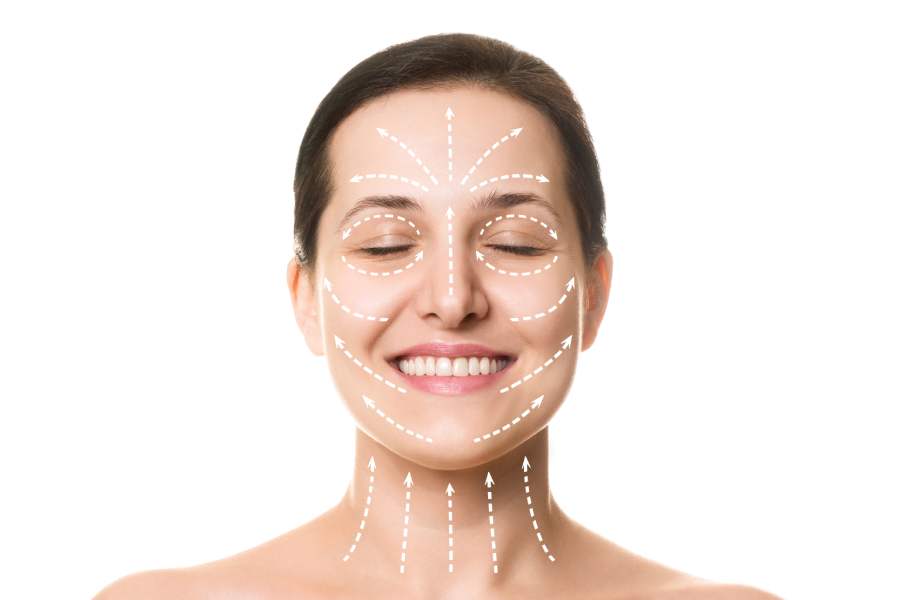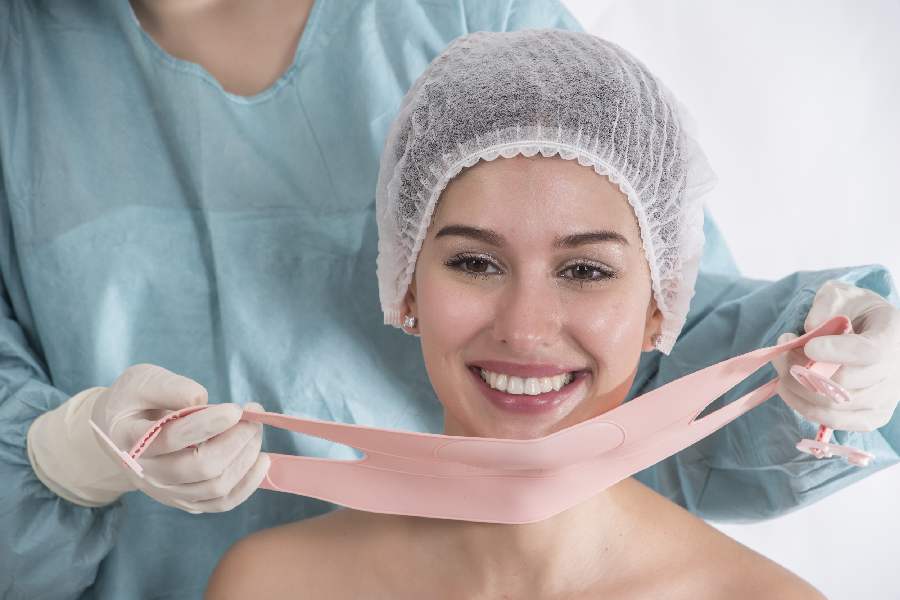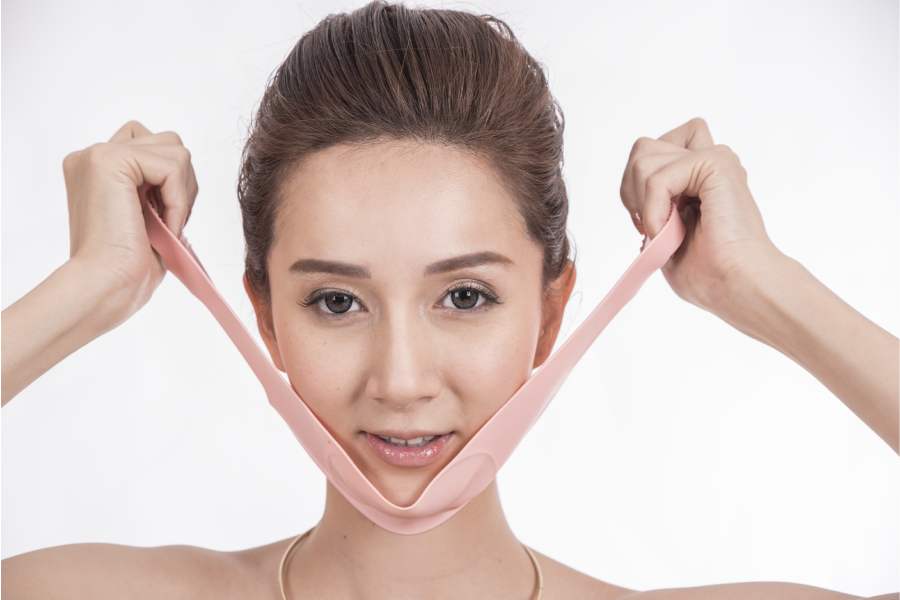Post-operational recovery is important in every esthetic correction. The same goes for facelifts. One of the most important things you need to know is how tight should chin strap be after facelift.
You might wonder why is a proper fit of the chin strap after facelift surgery so important. The procedure is done, and you might think that nothing can influence the procedure outcome.
Unfortunately, the reality is different. Chin straps play a huge role in the final results of the facelift. The chin strap allows the face tissues to heal well, and it might reduce swelling and pain after surgery.
So if you want a faster recovery process and to maintain the contours from the procedure, check out our expert advice for wearing a chin strap after a facelift.
[ez-toc]
The Purpose of a Chin Strap in Facelift Recovery
When you get home from your facelift procedure, you have to wear a chin strap for two weeks straight. You may remove the compression garment only when you are eating, showering, or cleaning the incisions.
You should consult with a professional about how long you are required to wear the compression garment, as it can vary according to your surgeon, individual circumstances, and healing rate.
After the first two weeks, your surgeon can ask you to wear the chin strap while you are at home for one or two more weeks.
The chin strap has multiple purposes after a facelift. The most important ones are:
- Contributing to proper healing
- Helps in closing the dead space
- Reduces internal bleeding
- Reduces scarring
- Makes the post-operative process easier for the patient
Proper healing
First and foremost, the garment prevents gravity from pulling your facial tissue downwards as it heals. The chin strap keeps your face in place and doesn’t let the gravitational pulling influence the contour the surgeon gave you.
Helps in closing the dead space
Secondly, the chin strap tightens the space between the tissue and the skin. This is known as closing the dead space.
When you have a facelift surgery, we might sculpt, move around, or remove fat from your face. That’s why you will need the chin strap to hold the pieces together as they heal.

Source: shutterstock.com/ Photo Contributor: n.k.junky
Reduces scarring
The pressure of the chin strap typically flattens the incisions, which might reduce scarring. But, you should be aware that the scarring depends on many factors, including your diet, genetics, direction of the wound or incision, and skin type.
Reduces internal bleeding
Furthermore, the compressions of the chin strap might reduce internal bleeding. The compression from the chin strap might move the fluids around. This may lower your risk of getting blood on the surface of the skin and bruising.
Makes the post-operative process easier for the patient
Lastly, the chin strap might make the whole post-operational process easier. It may promote draining and reduce blood clots. At the same time, the chin strap might help shape the face and provide you with comfort during your recovery.
Customization of the Chin Strap Based on Individual Needs
A facelift is one of the top five most common cosmetic surgical procedures. If you are one of the Americans who has undergone a facelift, it is normal to wonder how tight should chin strap be after facelift.
The chin strap should be adjusted according to your face shape and your recovery needs. First of all, you should be able to breathe, speak, and swallow without feeling huge discomfort.
So how tight should chin strap be after facelift? – The chin strap should be tight enough to provide gentle pressure and lay flat on your face.
Remember that the tightness level of the chin strap won’t be the same during your whole post-operative period. Adjusting the chin strap tightness post facelift according to your situation is key. You should do it gradually.
You might need to wear the chin strap tightly during the first few days after the procedure. This is normal because you may experience swelling, and the chin strap should be tight enough to control it.
As you get closer to the end of your recovery, your surgeon might advise you to loosen the strap. During the last days, the swelling might subside, your skin may heal, and you may not need to wear the chin strap as tight as before.

Source: shutterstock.com/ Photo Contributor: Supavadee butradee
Recommended Tightness Levels for Optimal Support and Healing
The recommended level of tightness for chin strap after facelift is different for each patient. The perfect tightness for you might not be the proper one for someone else.
However, one thing is common for each one: the chin strap should be snug enough to provide mild compression. The chin strap should provide the ultimate support for your face without causing pain or discomfort.
Balancing Comfort and Effectiveness of the Chin Strap
During the post-operational period, you should focus on resting and making yourself feel comfortable. Moreover, you should also pay attention to the tightness of the chin strap so you don’t reduce the effectiveness of the garment.
When adjusting the tension of the chin strap post facelift, you should consider how the chin strap feels on your face. At the same time, you should ensure the chin strap is compressed enough to serve its purpose while you are wearing it.
For the ultimate balance between comfort and effectiveness, you should look for the following signs indicating the chin strap is too tight.
- You feel excessive pressure on your face
- The fabric of the chin strap folds
Although it might seem a little hard to balance the two things, it will take you just a few adjustments to find the perfect tightness.
Adjusting the Strap Tension as Advised by the Surgeon
Following the surgery, you will spend the night in the facility. Use the time to talk with your surgeons. They can give you the best post-operative care instructions.
The surgeon will give you personalized advice on how to wear the chin strap. There are different types of chin straps. Your surgeon can tell you the proper fit of the chin strap after facelift surgery according to the model and your face.
Following all the specific guidelines your surgeon will give you after the facelift is important.
If you have other dilemmas about the procedure, except how tight should chin strap be after facelift, you should share them with your surgeon or other medical staff.

Source: shutterstock.com/ Photo Contributor: Supavadee butradee
Frequently Asked Questions
How long do you wear a chin strap after a lower facelift?
A chin strap is typically recommended for the first two weeks after a facelift. During this time, the compression garment should be worn constantly, except for showering, eating, and incision cleaning.
How long will my face feel tight after a facelift?
There is no one size fits all answer to this question. However, as a rule of thumb, you might feel tightness two or three months after the facelift procedure.
What happens if the compression garment is too loose?
If you wear your chin strap or compression garment too loose, you might make the recovery process harder, experience swelling, and increase the chances of scarring. Additionally, your skin might not heal properly, and you may not get the facelift results you desire.
How can I speed up my facelift recovery?
Some of the ways that might help you have an easier recovery from the facelift procedure are sleeping with an elevated head, taking multivitamins, eating healthy, wearing a chin strap properly, cleaning your incisions regularly, and avoiding direct sunlight.
Conclusion
Undergoing a facelift is a transformative esthetic surgery that can rejuvenate your appearance. But the process of feeling more beautiful and confident with the way you look doesn’t end when you get out of surgery.
The final results of your facelift also depend on your post-operational care. As we like to say, knowing how tight should chin strap be after facelift is just as important as the surgery itself.
Our responsibility will be to tighten your face skin and remove unwanted wrinkles and fat. It will be your job to stay by the recommended level of tightness for chin strap after facelift.
